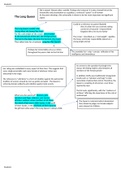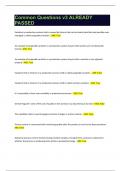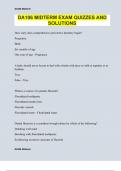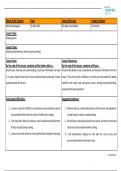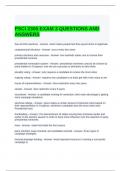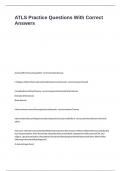Samenvatting Data Mining
Module 1 - Introduction and preliminaries
Pattern Classification
There are three numerical variables (features) to be used
to predict the outcome (decision class). Y is always a
category, not a number. Feature describe the problem
and the output is the target.
This problem is multi-class since we have three possible
outcomes.
The goal in pattern classification is to build a model able
to generalize well beyond the historical training data. We
want to build a model with this pattern classification which
can solve the problem of the last row.
Missing values
Sometimes, we have instances that have missing values
for some features.
It is of paramount importance to deal with this situation
before building any machine learning or data mining model.
The more information / data we have, the easier it is to
solve. When we delete missing values, we lose value.
Missing values might result from fields that are not always
applicable, incomplete measurements, lost values.
Imputation strategies for missing values
Remove features
The simplest strategy would be to remove the feature containing missing values. This
strategy is recommended when the majority of the instances (observations) have missing
values for that feature.
,→ However: There are situations in which we have a few features or the feature we want to
remove is deemed relevant.
Remove instances
If we have scattered missing values and a few features, we might want to remove the
instances having missing values.
→ However: There are situations in which we have a limited number of instances.
Replacing missing values
The third strategy is the most popular. It consists of replacing the missing values for a given
feature with a representative value such as the mean, the median or the mode of that
feature.
→ However: We need to be aware that we are introducing noise
Fancier strategies of estimating
These include estimating the missing values with a machine learning model trained on the
non-missing information.
Autoencoders to impute missing values
Autoencoders are deep neural networks that involve two neural blocks named encoder and
decoder. The encoder reduces the problem dimensionality while the decoder completes the
pattern.
→ They use unsupervised learning to adjust the weights that connect the neurons.
Unsupervised learning is a type of machine learning paradigm where the model learns
from unlabeled data without specific guidance or supervision in the form of labeled outcomes
or target variables. In other words, the algorithm explores patterns, structures, or
relationships within the data without knowing the correct answers in advance.
Missing values and recommender systems
,Feature scaling
Normalization
Different features might encode different measurements and
scales (e.g. the age and height of a person).
Normalization allows encoding all numeric features in the [0,1]
scale.
We subtract the minimum from the value to be transformed and
divide the result by the feature range.
This is applied to every number in the column.
Standardization
This transformation method is similar to the normalization, but the
transformed values might not be in the [0,1] interval.
We subtract the mean from the value to be transformed and
divide the result by the standard deviation.
Normalization and standardization might lead to different scaling
results.
Normalization versus standardization
Different scales can be put together in one scale with these procedures.
Differences and similarities:
- Difference: With standardization, there are no boundaries.
- Similarity: Both methods change the scales, but not the properties.
Which one to use? It depends, but you have to pay attention to the scale.
, Feature interaction
Correlation between two numerical variables
Sometimes, we need to measure the correlation between numerical features describing a
certain problem domain.
→ E.g. What is the correlation between gender and income in Sweden?
Correlation is a way to measure by how much the data is linear. With zero correlation, you
cannot see any relation.
Pearson’s correlation
It is used when we want to determine the correlation
between two numerical variables given k observations.
It is intended for numerical variables only and its value
lies in [-1,1].
The order of variables does not matter since the
coefficient is symmetric.
Example
0.53 is a medium, positive
correlation. The interpretation
is probably independent.
Module 1 - Introduction and preliminaries
Pattern Classification
There are three numerical variables (features) to be used
to predict the outcome (decision class). Y is always a
category, not a number. Feature describe the problem
and the output is the target.
This problem is multi-class since we have three possible
outcomes.
The goal in pattern classification is to build a model able
to generalize well beyond the historical training data. We
want to build a model with this pattern classification which
can solve the problem of the last row.
Missing values
Sometimes, we have instances that have missing values
for some features.
It is of paramount importance to deal with this situation
before building any machine learning or data mining model.
The more information / data we have, the easier it is to
solve. When we delete missing values, we lose value.
Missing values might result from fields that are not always
applicable, incomplete measurements, lost values.
Imputation strategies for missing values
Remove features
The simplest strategy would be to remove the feature containing missing values. This
strategy is recommended when the majority of the instances (observations) have missing
values for that feature.
,→ However: There are situations in which we have a few features or the feature we want to
remove is deemed relevant.
Remove instances
If we have scattered missing values and a few features, we might want to remove the
instances having missing values.
→ However: There are situations in which we have a limited number of instances.
Replacing missing values
The third strategy is the most popular. It consists of replacing the missing values for a given
feature with a representative value such as the mean, the median or the mode of that
feature.
→ However: We need to be aware that we are introducing noise
Fancier strategies of estimating
These include estimating the missing values with a machine learning model trained on the
non-missing information.
Autoencoders to impute missing values
Autoencoders are deep neural networks that involve two neural blocks named encoder and
decoder. The encoder reduces the problem dimensionality while the decoder completes the
pattern.
→ They use unsupervised learning to adjust the weights that connect the neurons.
Unsupervised learning is a type of machine learning paradigm where the model learns
from unlabeled data without specific guidance or supervision in the form of labeled outcomes
or target variables. In other words, the algorithm explores patterns, structures, or
relationships within the data without knowing the correct answers in advance.
Missing values and recommender systems
,Feature scaling
Normalization
Different features might encode different measurements and
scales (e.g. the age and height of a person).
Normalization allows encoding all numeric features in the [0,1]
scale.
We subtract the minimum from the value to be transformed and
divide the result by the feature range.
This is applied to every number in the column.
Standardization
This transformation method is similar to the normalization, but the
transformed values might not be in the [0,1] interval.
We subtract the mean from the value to be transformed and
divide the result by the standard deviation.
Normalization and standardization might lead to different scaling
results.
Normalization versus standardization
Different scales can be put together in one scale with these procedures.
Differences and similarities:
- Difference: With standardization, there are no boundaries.
- Similarity: Both methods change the scales, but not the properties.
Which one to use? It depends, but you have to pay attention to the scale.
, Feature interaction
Correlation between two numerical variables
Sometimes, we need to measure the correlation between numerical features describing a
certain problem domain.
→ E.g. What is the correlation between gender and income in Sweden?
Correlation is a way to measure by how much the data is linear. With zero correlation, you
cannot see any relation.
Pearson’s correlation
It is used when we want to determine the correlation
between two numerical variables given k observations.
It is intended for numerical variables only and its value
lies in [-1,1].
The order of variables does not matter since the
coefficient is symmetric.
Example
0.53 is a medium, positive
correlation. The interpretation
is probably independent.


